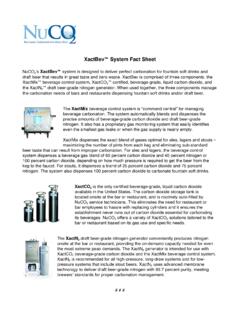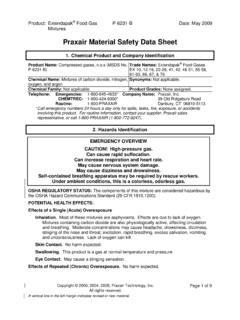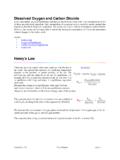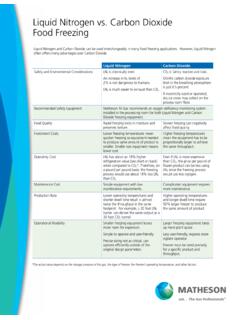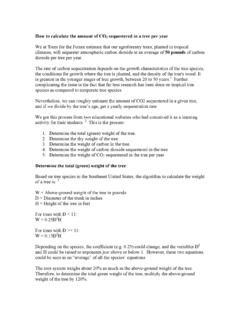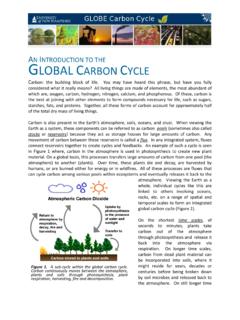Transcription of Carbon dioxide, refrigerated liquid - NuCO2: Beverage and ...
1 Carbon dioxide , refrigerated liquid Safety Data Sheet P-4573 according to Code of Federal Regulations 29 CFR , Hazard Communication. Date of issue: 01/01/1997 Revision date: 12/18/2014 Supersedes: 12/01/2009 EN (English US) SDS ID: P-4573 1/9 This document is only controlled while on the Praxair, Inc. website and a copy of this controlled version is available for download. Praxair cannot assure the integrity or accuracy of any version of this document after it has been downloaded or removed from our website. SECTION: 1. Product and company identification Product identifier Product form : Substance Name : Carbon dioxide , refrigerated liquid CAS No : 124-38-9 Formula : CO2 Other means of identification : Liquiflow liquid Carbon dioxide , Medipure liquid Carbon dioxide Relevant identified uses of the substance or mixture and uses advised against Use of the substance/mixture : Industrial use Medical applications.
2 Food applications. Details of the supplier of the safety data sheet Praxair, Inc. 39 Old Ridgebury Road Danbury, CT 06810-5113 - USA T 1-800-772-9247 (1-800-PRAXAIR) - F 1-716-879-2146 Emergency telephone number Emergency number : Onsite Emergency: 1-800-645-4633 CHEMTREC, 24hr/day 7days/week Within USA: 1-800-424-9300, Outside USA: 001-703-527-3887 (collect calls accepted, Contract 17729) SECTION 2: Hazards identification Classification of the substance or mixture Classification (GHS-US) refrigerated liquefied gas H281 Full text of H-phrases: see section 16 Label elements GHS-US labeling Hazard pictograms (GHS-US) : GHS04 Signal word (GHS-US) : Warning Hazard statements (GHS-US) : H281 - CONTAINS refrigerated GAS; MAY CAUSE CRYOGENIC BURNS OR INJURY OSHA-H01 - MAY DISPLACE OXYGEN AND CAUSE RAPID SUFFOCATION. CGA-HG03 - MAY INCREASE RESPIRATION AND HEART RATE. Precautionary statements (GHS-US) : P202 - Do not handle until all safety precautions have been read and understood P271+P403 - Use and store only outdoors or in a well-ventilated place.
3 P282 - Wear neoprene gloves, eye protection, face shield, protective clothing, cold insulating gloves CGA-PG05 - Use a back flow preventive device in the piping. CGA-PG24 - DO NOT change or force fit connections. CGA-PG06 - Close valve after each use and when empty. CGA-PG23 - Always keep container in upright position. Carbon dioxide , refrigerated liquid Safety Data Sheet P-4573 according to Code of Federal Regulations 29 CFR , Hazard Communication. Date of issue: 01/01/1997 Revision date: 12/18/2014 Supersedes: 12/01/2009 EN (English US) SDS ID: P-4573 2/9 This document is only controlled while on the Praxair, Inc. website and a copy of this controlled version is available for download. Praxair cannot assure the integrity or accuracy of any version of this document after it has been downloaded or removed from our website. Other hazards Other hazards not contributing to the classification : Asphyxiant in high concentrations.
4 Contact with liquid may cause cold burns/frostbite. Unknown acute toxicity (GHS-US) No data available SECTION 3: Composition/information on ingredients Substance Name Product identifier % Carbon dioxide , refrigerated liquid (Main constituent) (CAS No) 124-38-9 100 Mixture Not applicable SECTION 4: First aid measures Description of first aid measures First-aid measures after inhalation : Remove victim to uncontaminated area wearing self contained breathing apparatus. Keep victim warm and rested. Call a doctor. Apply artificial respiration if breathing stopped. First-aid measures after skin contact : For exposure to liquid , immediately warm frostbite area with warm water not to exceed 105 F (41 C). Water temperature should be tolerable to normal skin. Maintain skin warming for at least 15 minutes or until normal coloring and sensation have returned to the affected area. In case of massive exposure, remove clothing while showering with warm water.
5 Seek medical evaluation and treatment as soon as possible. First-aid measures after eye contact : Hold the eyelids open and away from the eyeballs to ensure that all surfaces are flushed thoroughly. Get immediate medical attention. Immediately flush eyes thoroughly with water for at least 15 minutes. First-aid measures after ingestion : Ingestion is not considered a potential route of exposure. Most important symptoms and effects, both acute and delayed No additional information available Indication of any immediate medical attention and special treatment needed None. SECTION 5: Firefighting measures Extinguishing media Suitable extinguishing media : Use extinguishing media appropriate for surrounding fire. Special hazards arising from the substance or mixture Reactivity : No reactivity hazard other than the effects described in sub-sections below. Advice for firefighters Firefighting instructions : DANGER!
6 Extremely cold liquid and gas under pressure. Take care not to direct spray onto vents on top of container. Do not discharge sprays directly into liquid ; cryogenic liquid can freeze water rapidly. Evacuate all personnel from the danger area. Use self-contained breathing apparatus (SCBA) and protective clothing. Immediately cool containers with water from maximum distance. Stop flow of gas if safe to do so, while continuing cooling water spray. Remove ignition sources if safe to do so. Remove containers from area of fire if safe to do so. On-site fire brigades must comply with OSHA 29 CFR and applicable standards under 29 CFR 1910 Subpart L Fire Protection. Protection during firefighting : Compressed gas: asphyxiant. Suffocation hazard by lack of oxygen. Special protective equipment for fire fighters : Use self-contained breathing apparatus. Standard protective clothing and equipment (Self Contained Breathing Apparatus) for fire fighters.
7 Carbon dioxide , refrigerated liquid Safety Data Sheet P-4573 according to Code of Federal Regulations 29 CFR , Hazard Communication. Date of issue: 01/01/1997 Revision date: 12/18/2014 Supersedes: 12/01/2009 EN (English US) SDS ID: P-4573 3/9 This document is only controlled while on the Praxair, Inc. website and a copy of this controlled version is available for download. Praxair cannot assure the integrity or accuracy of any version of this document after it has been downloaded or removed from our website. Specific methods : Stop flow of product if safe to do so. Use fire control measures appropriate for the surrounding fire. Exposure to fire and heat radiation may cause gas containers to rupture. Cool endangered containers with water spray jet from a protected position. Prevent water used in emergency cases from entering sewers and drainage systems. Use water spray or fog to knock down fire fumes if possible.
8 If leaking do not spray water onto container. Water surrounding area (from protected position) to contain fire. Exposure to fire may cause containers to rupture/explode. Other information : Cryogenic liquid causes severe frostbite, a burn-like injury. Heat of fire can build pressure in a closed container and cause it to rupture. Venting vapors may obscure visibility. Air will condense on surfaces such as vaporizers or piping exposed to liquid or cold gas. Nitrogen, which has a lower boiling point than oxygen, evaporates first, leaving an oxygen-enriched condensate. SECTION 6: Accidental release measures Personal precautions, protective equipment and emergency procedures General measures : Prevent from entering sewers, basements and workpits, or any place where its accumulation can be dangerous. Evacuate area. Ensure adequate air ventilation. Wear self-contained breathing apparatus when entering area unless atmosphere is proven to be safe.
9 Stop leak if safe to do so. For non-emergency personnel No additional information available For emergency responders No additional information available Environmental precautions Try to stop release. Methods and material for containment and cleaning up No additional information available Reference to other sections See also sections 8 and 13. SECTION 7: Handling and storage Precautions for safe handling Precautions for safe handling : Wear leather safety gloves and safety shoes when handling cylinders. Protect cylinders from physical damage; do not drag, roll, slide or drop. While moving cylinder, always keep in place removable valve cover. Never attempt to lift a cylinder by its cap; the cap is intended solely to protect the valve. When moving cylinders, even for short distances, use a cart (trolley, hand truck, etc.) designed to transport cylinders. Never insert an object ( , wrench, screwdriver, pry bar) into cap openings; doing so may damage the valve and cause a leak.
10 Use an adjustable strap wrench to remove over-tight or rusted caps. Slowly open the valve. If the valve is hard to open, discontinue use and contact your supplier. Close the container valve after each use; keep closed even when empty. Never apply flame or localized heat directly to any part of the container. High temperatures may damage the container and could cause the pressure relief device to fail prematurely, venting the container contents. For other precautions in using this product, see section 16. Conditions for safe storage, including any incompatibilities Storage conditions : Store in a cool, well-ventilated place. Store and use with adequate ventilation. Store only where temperature will not exceed 125 F (52 C). Firmly secure containers upright to keep them from falling or being knocked over. Install valve protection cap, if provided, firmly in place by hand. Store full and empty containers separately.


